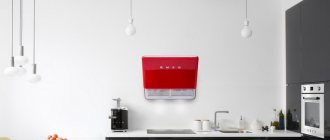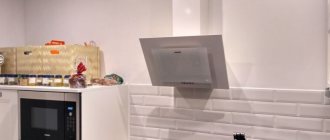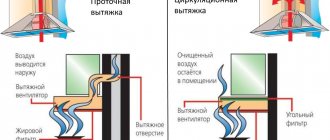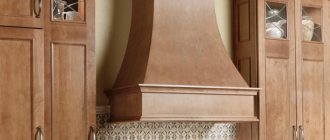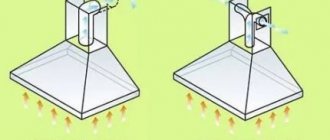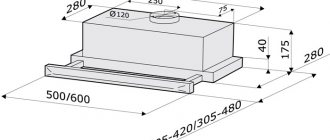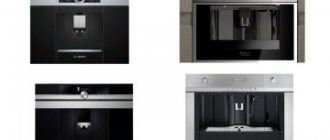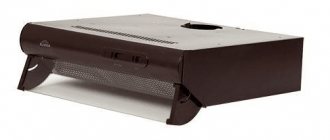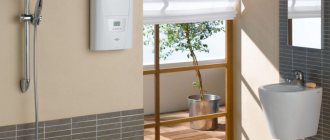Circulation and drainage: what is it and why is it important?
During the cooking process, a lot of steam, droplets of fat, odors are released, and walls, dishes and furniture become covered with a coating that is difficult to remove. A hood will solve this problem. There are two main types of this technique:
- recirculation;
- with outlet to ventilation.
The first type absorbs air, filters it and returns it back to the room. The second one simply takes air from the room and takes it outside through the wall (in a private house) or into a common ventilation duct (in an apartment building), so the work of the exhaust is considered more effective - the air is purified by 99%.
Exhaust mode - pros and cons
Devices that remove “exhaust” air from the room are considered more efficient, since they do not require additional ventilation in the form of household air recuperators, ventilators, and various fans.
Advantages of hoods with outlet
- High-quality air exchange.
- Variety of models, ease of integration into the interior.
- Wide power range.
- Various price ranges of units.
- The operation of the unit is based on the removal of air to the outside. Most often, only a coarse filter is used, which is reusable and easy to maintain and clean.
Disadvantages of exhaust systems with venting to ventilation
- The need to install an air duct.
- The choice of installation location for the system directly depends on the location of the ventilation hole.
- The longer the pipeline, the higher the power loss. The same applies to the number of bends in the outlet pipe.
- It is advisable to provide a check valve to prevent the entry of air and odors from the mine.
- It is advisable to trust the design of the system, installation of the device and its debugging to professionals. This will minimize power losses. The list of services, terms of provision and prices can be found on the website or by phone.
Design and principle of operation of a hood with outlet
The device can be divided into several parts:
- The body itself usually consists of plastic, metal or glass. It has a control panel with several modes and a backlight that allows you to cook even when the lights are off;
- one or two fans that affect the air replacement rate;
- metal filter that absorbs soot and grease. Easy to care for. Some manufacturers equip the hood with disposable filters, which is more expensive;
- pipe for connection to the ventilation duct;
- pipe box
When you turn on the hood, air begins to be sucked (against its will) into the unit, where it undergoes rough mechanical cleaning, as well as removal of odors.
After treatment, the air masses are released into the ventilation - the environment does not suffer from this, and the kitchen remains clean and fresh. Since air is actively drawn from the kitchen, and there is no influx of new air, it is necessary to avoid the effect of reverse draft. To do this you need to open a window.
Recycling
Recirculation – filter mode. The air does not escape outside, it circulates inside the exhaust structure
, goes through several stages of cleaning and returns back to the room. Some people believe that a hood must exhaust air outside, and that equipment in recirculation mode is just a purifier.
It is much easier to set the hood to the “circulation” mode than to the “exhaust” mode. All you need to do is install filters
and you can immediately begin operating the equipment; in the second case, you need to select an air duct and install a pipe outlet, which may be associated with some difficulties.
Kinds
There are several types of hoods with outlet. Each has its own characteristics and purpose.
| Hanging | The simplest and most common type of hood. Suitable for small kitchens as it has only one motor. Inconspicuous, mounted above the stove on the wall or under a shelf. |
| Built-in | As the name implies, this type of hood is built into furniture, so it will suit almost any interior. Most often it is made of metal, since the main part of the body is still not visible. It will also fit into a large kitchen, as there are models with two fans. |
| Ostrovnaya | Suitable for a kitchen with an island layout. The hood is attached to the ceiling above the stove located in the island. Most often it is made of stainless steel and fits only into modern styles. The main problem is to find a place for the ventilation housing. |
| Fireplace | The most expensive, but also powerful version of the hood. To install it, consultation with a specialist is required. The price provides almost any appearance (even wood or metal), the availability of a variety of lighting and many additional functions. It copes well with spacious rooms, but requires a large ventilation capacity, so it is often vented to the street. |
| Inclined | The working surface is located at an angle to the stove. It is gaining popularity among housewives of small kitchens; it looks unusual, but this makes it less powerful. Can be of any size, shape and material. Easy to maintain. |
| Corner | It is quite rare, since it is completely unjustified in practice. Suitable only for those cases when there is a stove in the corner of the kitchen, which means that most of the space is not used, so such a move in the correct layout is quite rare. There are models with side outlet. |
Ventilation requirements
The basic requirements and standards that determine how to make ventilation in each room in the house are contained in SNiP. It is necessary to comply with the specified rates of air mass change frequency, temperature and humidity indicators, etc. This is facilitated, first of all, by natural ventilation in the house and apartment. Apartment buildings are initially built with ventilation shafts designed for natural ventilation of living rooms, kitchens and bathrooms. The ventilation system in the kitchen in your home and other rooms is designed in advance.
In a private house, ventilation ducts must be built in the kitchen, bathroom, boiler room and other technical rooms, characterized by a certain percentage of air pollution.
General sanitary and hygienic requirements for ventilation for an apartment, in a house:
- ventilation systems in the bathroom and kitchen are installed independently and should not intersect to prevent air flow from one room to another;
- ventilation systems in the bathroom, toilet and kitchen should not be combined with the general ventilation scheme for living rooms;
- The air removed from the bathroom and kitchen area must be discharged to the street through the roof of a private house. In the apartment - through ventilation shafts;
- The air in the kitchen can be reused only after cleaning with a recirculating hood;
- the kitchen ventilation opening cannot be completely covered with a kitchen hood pipe with an outlet into the ventilation;
- For the ventilation system to operate effectively, it is necessary to ensure a flow of fresh air into the premises.
Advantages and disadvantages
Usually, a hood with an outlet is installed only for a gas stove, since due to open fire it is the one that produces the most soot and grease. But such a hood will also be justified with, for example, an electric or induction stove - there are a number of advantages:
- environmental friendliness - the room remains fresh, the air is purified, but the environment does not suffer from this. The air is released with a large amount of carbon dioxide, but without coarse impurities, fat and soot;
- profitability - manufacturers took care of this factor. Now there are many models on the market with efficiency class A+ and higher;
- health - clean air has a positive effect on a person compared to polluted air;
- easy maintenance - filters are easy to remove and wash, and if necessary, easy to replace;
- versatility - there is such a variety of models on the market that the equipment can fit into any interior;
- noiselessness - modern models are so quiet that they will not disturb neighbors even during long-term operation;
- power - clean and fresh air in just a few minutes is possible thanks to forced ventilation.
Yes, there are many positive aspects when installing a hood with a ventilation outlet, but there are also negative aspects. The main factor is the need to install an air duct. This will make the ceiling heavier and will also require additional cash costs.
Most often, an electrician is needed for proper installation, since independent installation can lead to incorrect operation or even breakdown of the equipment. And the price of exhaust hoods itself is significantly higher than circulation models.
Pros and cons of recirculating devices
In order to wisely choose a kitchen hood without venting to ventilation, you need to know about the advantages of such devices:
- products are mounted in any convenient place, without connecting to ventilation;
- the devices do not require constant exhaust; this is important for apartments or houses with plastic doors and windows that are hermetically sealed;
- the appliances are conveniently placed in the kitchen, complement the interior and at the same time do not take up extra space;
- hoods without outlet have a clear design and simple installation that does not require special knowledge and skill;
- The products are easy to maintain - when replacing the activated carbon filter in the hood, there is no need to involve specialists.
At the same time, such hoods without an air duct also have disadvantages during their operation:
- Replacement of filter elements is required after 3-6 months, depending on the load. You also need to regularly wash the grease receiver. All this requires certain expenses.
- In general, the efficiency of a recirculating unit for eliminating odors is slightly lower compared to how a recirculating system works in a kitchen.
- Relatively high noise level.
Thus, when choosing the type of hood, you need to weigh the pros and cons and only then make a decision for yourself.
How to choose the best model?
At first glance, choosing a suitable model is quite difficult, since there are a great many of them on the market. But if you structure the selection process correctly, the best option will appear almost automatically.
You need to start sifting with technical characteristics and dimensions, and then focus on the manufacturer.
Dimensions and technical characteristics
The body itself, its material and color are selected based on personal preferences and the style of the kitchen as a whole, its color scheme and design. The dimensions of the hood depend on the size of the stove: according to the rules, the hood should be either wider or longer than the hob. Usually they choose the wider option, otherwise there is a risk of hitting the hood with your head when cooking. The optimal width is 10 centimeters larger than the slab.
The standard width is from 50 to 90 centimeters, but there are also more exotic options from 30 to 120 centimeters. It is worth noting that size and power are in no way related.
There is a special formula that will help estimate the required power of the equipment. To do this, you need to calculate the volume of the kitchen (multiply the height, length, width - for example, 3 m by 5 m by 4 m - 60 cubic meters) and multiply it by 12 (720 W).
This results in the minimum required power. To find out the optimal one, you need to multiply the resulting figure by another 1.3.
Noise level
Noise is an integral part of the operation of the hood, since the air movement itself is provided by fans. If there are two fans, the room will become fresher faster, but more noise will be created. If there is only one fan, then the air intake process will be quieter, but slower.
There are sanitary standards that set the maximum noise level:
- 55 dB - during the day;
- 40 dB - at night.
For comparison, this is the sound of heavy rain in an open space or the rustling of leaves in a light wind. A comfortable volume for a person is 20–35 dB - this is what you should focus on. Of course, the lower the noise level and the higher the performance, the more expensive the equipment will be.
Backlight
This is not an essential item, but a rather convenient feature that is currently available in almost all models. The backlight is convenient when you need to go to the stove and check the dish being prepared, but you don’t have to turn on the main light.
It is worth noting that the light bulbs in hoods are also different:
- incandescent - an old option that is found in cheap hoods. Most often, low-quality light bulbs are installed, which quickly overheat and burn out;
- halogen - the most common option;
- LEDs are the best option because they consume a minimal amount of electricity but produce very bright light.
If the selected model does not have backlighting, then you should consider additional lighting for the work area yourself.
Control method
It is rare that the control method becomes the determining factor when choosing equipment, but this also happens. For example, in a high-tech style, an old mechanical control may not fit into the interior, since such a design requires the most modern solutions.
| Mechanical | The simplest and cheapest option is control using buttons and toggle switches. With their help, you can turn the hood on and off, adjust the power or mode. It is easy to use and repair if necessary. |
| Electronic | Typical of modern models. Control occurs using a screen with touch buttons. More expensive models have a remote control function. Convenient to clean. |
| Electromechanical | This type combines the previous two. |
If possible, it is better to choose models with remote control, since this is a very convenient solution that allows you not to go to the equipment to turn it on or off.
Types of air duct
The duct is an important part of the kitchen and hood. It determines how well the air will escape. The air duct must be of high quality, durable, but at the same time not attract unnecessary attention. Based on materials, the following types of bends are distinguished:
- plastic is the most effective solution, since aerodynamic losses are minimal, that is, ideal conditions are created for the passage of air;
- metal - reliable, but very noisy;
- fabric - outdated and unreliable option;
- corrugated - an economical and simple solution, takes almost any shape, is easy to install, but cannot be used longer than two meters.
You can use any one for the hood. But there are several rules for correct use:
- do not bend the hose - the maximum permissible number of bends is 3, because each turn reduces the power by 10%;
- the diameters of the hose and the outlet of the equipment must match;
- the fastening must be made as reliable as possible;
- allow for quick disassembly for regular cleaning;
- the pipe should not completely cover the ventilation hole in the wall - this will interfere with the flow of air.
It would be a good idea to install a special valve that reacts to backdraft in the hood and prevents it.
Manufacturer
The manufacturer also plays a significant role when choosing equipment.
| Brand | Description | average cost |
| Bosch | The German manufacturer is distinguished by a wide range of models of almost any household appliance. Hoods are reliable, convenient and efficient. | 5.5–15.5 thousand rubles. |
| Siemens | Siemens hoods are distinguished by their noiselessness, which is important, for example, if you have small children or pets who cannot tolerate noise well. This is a great combination of quality and style. | 10.5–30.5 thousand rubles. |
| Elica | The company follows innovation and therefore constantly introduces new technologies. The equipment is made from high-quality materials, and the resulting forms look extremely laconic. | 4.5–15.5 thousand rubles. |
| Elikor | Hoods from this manufacturer are distinguished by wide functionality and additional options. Control is usually electronic using a panel. | 2.5–20 thousand rubles. |
| Samsung | Samsung appliances are made in a simple and classic style, so they are more suitable for a kitchen with a modern design. | 6.5–20 thousand rubles. |
| Gefest | The Hephaestus brand offers a wide variety of hoods. Thanks to this choice, you can choose the ideal option just for you. If you need high-quality, but inexpensive equipment, go to Hephaestus. | 2.5–17.5 thousand rubles. |
| Gorenje | A Slovenian brand that produces various household appliances, including hoods - the model range is wide. Gorenje produces beautiful and high-quality products. It is assembled in Poland - it deserves attention only because of this. | 2.5–25 thousand rubles. |
Kitchen design with box
Inside some standard apartments there is a kitchen with a ledge - these are ventilation ducts, inside of which there are exhaust air removal shafts. Ventilation of the kitchen and living rooms, kitchen and bathroom, as a rule, are divided into autonomous ventilation ducts.
Ventilation ducts can be:
- small (depth, width up to 60 cm);
- large (more than 60 cm);
- rectangular;
- complex shape.
Such ventilation ducts form niches inside the kitchen, which, with the right approach, can be used functionally. Cleaning, closing, or performing installation work on such structures is strictly prohibited, as this will disrupt the natural ventilation of the entire house.
Options for arrangement and use of ventilation ducts:
- niches inside the kitchen can be used as a cabinet for storing kitchen utensils;
Example in the photo
- a small corner ventilation duct can fit perfectly into the design of kitchen furniture;
- include in the overall interior as a decorative element;
- if space allows, you can install a fireplace;
- you can hang a mirror on the wall of the box;
- place a panel for storing small kitchen utensils, knives, and other utensils.
For a private house, this problem is not relevant due to the layout features. Here, kitchen ventilation calculations are made at the house design stage.
When deciding how to make ventilation in a house or apartment, you should separately calculate the ventilation of the kitchen, since a comfortable stay inside the living space largely depends on this.
Video on the topic
Features of use
The service life and operation of any equipment depends, among other things, on the attitude towards it and proper operation. There are several nuances regarding the hood that must be taken into account:
- the distance between the gas stove and the hood must be at least 80 centimeters. If the stove is electric, then 70 centimeters is permissible;
- The hood should not be narrower than the stove. Minimum - the same, preferably 10 centimeters wider;
- it is important to monitor the condition of the air duct: regularly clean and check for integrity;
- do not turn on the equipment immediately to the maximum level - do it step by step;
- the optimal operating time is to turn on 15 minutes before the start of cooking and turn off 20 minutes after the end;
- It is also important to keep the filters clean.
Sometimes a ventilation pipe spoils the design of a room. In this case, a special box is made for it from plastic or plasterboard, thanks to the finishing of which you can achieve an ideal combination with the interior. There are two more options to hide the tap:
- place it above the suspended ceiling;
- place it above the upper cabinets of the set.
Both options have disadvantages. For example, not everyone will decide to make a ceiling, and wall cabinets will not hide the outlet as much as possible. But these are common methods, so it's worth thinking about them in advance.
Kitchen ventilation in a private house
A private cottage, like an apartment building, is initially designed with an organized natural ventilation system. Ventilation ducts are primarily installed in those rooms where heat and moisture excesses, unpleasant or specific odors, etc. will appear. First of all, exhaust ducts are installed in the bathroom, kitchen, and furnace room, because this is where most of the listed air pollutants are formed. Supply ventilation is carried out naturally or through wall and window ventilation ducts.
Effective ventilation in cafes
Kitchen ventilation in a private house performs the following functions:
- removal to the street of gases hazardous to health that are formed during the cooking process, for example, carbon monoxide that appears when using a gas stove;
- removal of excess thermal energy that appears in the kitchen during the use of kitchen equipment (stove, oven, electric kettle, refrigerator, water heater, steamer, etc.);
- removal of air flow containing excess water vapor, which has a particularly negative effect on furniture, wall decoration, and ceilings;
- Together with the removed air, ventilation in the kitchen with a hood allows you to get rid of particles of fat, oil, soot or smoke;
- removal of odors arising during cooking.
Preparing for installation
The first step to begin installing a new hood is preparing the site. will help you do everything correctly :
- remove the equipment from the packaging, check the completeness, make sure there are no external deformations;
- decide on the place where the hood will hang, clean it;
- draw a line on the wall at the level at which the purchase will be hung (using a level) and draw a line where the air duct will lead out;
- use a marking template and mark future mountings on the wall;
- drill the wall according to the template and ruler.
These instructions are suitable for a regular hanging hood. If the appliances are built-in, then you will have to make a separate cabinet for it with a front like the one hanging next to it. At this stage, you need to find out whether the hood can be vented into general ventilation.
Installing a hood with your own hands | How to install a hood in the kitchen |
Masking the air duct pipe: all options and practical ideas
The stylistic design of the kitchen premises presupposes strict adherence to the general design idea, for which all communications are hidden and disguised, decorated in different ways:
- volumetric or flat pipe box. Focusing on the expanded range of offers from manufacturers, you can inexpensively purchase a plastic or metal box; models of different designs and configurations are available on the market;
- decorative design made of plasterboard. If you wish and have certain skills in working with building materials, it is very easy to make a box with your own hands, but for this it is important to know the dimensions of the structure and carefully make all the calculations;
- camouflage under plastic panels. When installing and installing an air duct during construction, cosmetic or major repairs, communications are hidden under plastic panels installed in the kitchen;
- decoration in the construction of a suspended ceiling. Ceiling panels mounted on a special frame are excellent for masking utility lines, but they reduce the height of the room, which is unacceptable for small kitchens.
The optimal solution to save money and decorate your kitchen space beautifully and tastefully are metal or plastic boxes for air ducts.
Without knowing how to install a polymer or metal hood box, you should carefully study the technology of securing the structure and prepare the necessary materials, fasteners and tools. It is recommended to entrust this work to experienced and trained craftsmen; the appearance of the kitchen will depend on the quality of the activities carried out and the practical, operational parameters of the selected devices and accessories.
Hood care
For equipment to serve for a long time, it must be kept clean. This also applies to the hood, especially since caring for it is extremely simple:
- First you need to turn off the power to the equipment.
- Remove the grate and wash it.
- Wipe the body and parts that may have become dirty.
- Wipe the buttons with a soft cloth soaked in soapy water.
For cleaning, it is better to give preference to mild detergents - soap, gel, foam. Abrasive substances are best avoided as they can scratch the surface and become a cozy home for bacteria.
The best kitchen design ideas with a hood
It’s not enough to choose a hood and learn how to properly care for it. It is also important to fit it correctly into the interior so that it does not attract too much attention to itself, but at the same time retains its functions. From the design side, there are four interesting solutions for how you can use the technology.
Idea 1. Contrast - select a technique that contrasts with the apron. For example, there is a black hood on a white tile, or vice versa. You can also use color options, for example, blue and white or yellow.
Idea 2. Emphasis on the hood. Choose a technique that is indistinguishable from a work of art. Most often, metal surfaces are used for this, which can be duplicated with door handles or a faucet.
Idea 3. Massiveness. In this case, the emphasis also shifts towards the hood, but not due to its originality, but due to its size. Some people call such specimens fireplace, but they will also take root well in a city apartment and create a cozy atmosphere. But this option is not suitable for small kitchens.
Idea 4. If you choose a classic interior style, then choosing a hood is very difficult. In this case, it is much easier to hide it behind the facade . Guests may not even realize that equipment is hidden in one of the wall cabinets.
Textile materials
In the market of modern engineering communications for the formation of a high-quality exhaust system, you can also find textile pipes for arranging ventilation, which easily fit into polymer or metal boxes; they are characterized by:
- minimal weight, which eliminates the creation of a certain load on the entire air exhaust system from the room;
- no condensation, moisture does not accumulate on the textile surface of the pipe, absorbed due to its texture and structure;
- with high pressure in the system resulting from incorrect calculation of power, the pipe can allow air to flow back into the kitchen.
The distinctive features of textile structures are their very high cost and the possibility of manufacturing only to order; the need to purchase a box for the hood is due to the unaesthetic appearance of such a pipe.
Advice from professionals
It is always difficult to choose household appliances, since it is too important a decision. A selection of advice from experts will help you decide.
Dmitry, sales consultant at a hypermodel of equipment: “People often cannot decide on the type of hood: with a vent or a recirculation one. There are universal models that support both operating modes. First, you can hang up the equipment and check the filtration mode - if the quality is not satisfactory, then connect it to ventilation.”
Evgeniy, store manager: “If there are smokers in the family, then you should definitely pay attention to the presence of a carbon filter - it absorbs tobacco smoke perfectly. If finances allow, then it is better to choose equipment with automatic gear switching - the equipment itself reacts to changes in air composition and selects the required mode.”
Konstantin: “It is better to choose hood models where the outlet of the equipment is slightly smaller than the inlet of the ventilation shaft - this will reduce the load on the device’s motor, which means that the noise level will be lower and the work will be more efficient.”
Alexey, sales manager: “There is one life hack for those who want a powerful but quiet hood, but don’t want to overpay - it’s better to choose equipment with two average-power fans than with one cool one. The performance will be the same, but the noise level will be noticeably lower.”
How to choose a kitchen hood
Which hood is right for your kitchen?
When choosing a hood for the kitchen, it is important to evaluate its technical characteristics. Here you need to take into account the power of air passing through the hood during an hour of operation.
If you have a small kitchen where you don’t cook very often, then a hood with a capacity of 150-300 m3 per hour is quite suitable. If there are 3-4 people in a family, then you should take a closer look at a more powerful hood with performance from 400 to 500 m3 per hour.
It is also worth considering the air exchange rate, which means the ratio of the volume of the kitchen with purified air within an hour. The norm will be if the air is renewed 6 to 12 times within an hour.
For example, having a kitchen with a volume of 25 cubic meters (area 10 square meters and height 2.5 meters), you can update the air 6 times using a hood with a capacity of 150 m3 per hour.
Now you need to figure out the size of the hood and the required distance from the stove. The optimal size of the hood will be identical to the size of the tile, which means that a hood size of 50 by 60 cm will not be enough, since the width of the hob is on average 60-90 centimeters.
Therefore, despite the air draft and the size of the air duct, you are unlikely to achieve the desired effect with such a small hood. If you want to clean the air as much as possible, then with a stove width of 90 centimeters, the width of the hood should be at least 120 cm.
As for the installation height, the distance from the hood to the hob should not be less than 65 cm, which will help to avoid overheating of the equipment and the occurrence of a flammable situation.
Housewives reviews
Once the hood has been selected, you should pay attention to the reviews about the specific model. Sometimes they can provide a lot of additional information.
Irina about Kaiser AT 6407 FW : “For me, the microclimate in the kitchen is very important, so I chose an above-average hood. I have a small kitchen, so I settled on the inclined version. There were doubts that the equipment would not cope, that there would not be enough power - but this is all nonsense. The Kayser works perfectly, there is not a trace of the smell of food left. When installing, you need to take into account that this is tempered glass, so the hood weighs about 30 kg, but it is packaged just fine. I like that the controls are touch-sensitive and easy to clean.”
Sofia about Elikor Integra 50: “The built-in feature of the hood was important to me, since I’m not a fan of something extra sticking out and distracting. I chose it based on reviews and was very pleased - the price-quality ratio is excellent. Connected to your ventilation - it removes odors perfectly even at medium power. I only use the maximum one if something burns.”
Svetlana about the Krona Inga 600: “I am very pleased with my purchase, because the hood is easy to care for, but at the same time it does its job with five stars. For example, at minimum (!) power it holds an A4 sheet of paper without any problems. Before this, I had another hood - a recirculating one. So the old one couldn’t do this even at maximum speed.”

